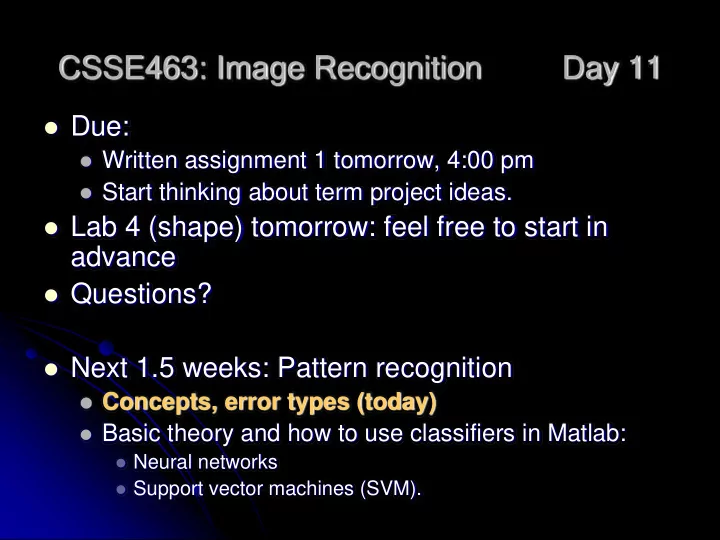

CSSE463: Image Recognition Day 11 � Due: � Written assignment 1 tomorrow, 4:00 pm � Start thinking about term project ideas. � Lab 4 (shape) tomorrow: feel free to start in advance � Questions? � Next 1.5 weeks: Pattern recognition � Concepts, error types (today) � Basic theory and how to use classifiers in Matlab: � Neural networks � Support vector machines (SVM).
Pattern recognition � Making a decision from data � A classification problem: assign a single class label to a datum point � Can include a special class, reject , � if a sample (a single datum point) appears not to belong to any known class � If it is on the boundary between classes � Else forced classification � Boundaries between classes-how? � There’s tons of theory, can be applied to many areas. We focus on small subset of those used for vision Q1
Baseline: Hand-tuned decision boundaries � You did this based on observations for fruit classification � You’ll do the same thing in Lab 4 for shapes � But what if the features were much more complex? � We now discuss classifiers that learn class boundaries based on exemplars (e.g., labeled training examples)
Ex: Nearest neighbor classifier � Assumes we have a feature vector for each image � Calculate distance from new test sample to each labeled training sample . � Assign label as closest training sample � Generalize by assigning same label as the majority of the k nearest neighbors. No majority? − = − + − 2 2 In 2 D , p p ( p ( x ) p ( x )) ( p ( y ) p ( y )) 1 2 1 2 1 2 d ∑ − = − 2 In dD , p p ( p ( i ) p ( i )) 1 2 1 2 = i 1
Nearest class mean � Find class means and Test point calculate distance to each mean � Pro? � Con? � Partial solution: clustering � Learning vector LVQ quantization (LVQ): tries to find optimal clusters Q2
Common model of learning machines Statistical Labeled Extract Features Learning Training (color, texture) Images Summary Classifier Test Extract Features Label Image (color, texture)
Focus on testing � Let m = the number of possible class labels � Consider m==2. � Example: Calculate distance to cluster means for 2 classes. Dist/prob 1 Test Class: Extract Features Decide Image 1, 2 (color, texture) Dist/prob 2
Multiclass problems � Consider m>2. � Example: Calculate distance to cluster means for 10 classes. Dist/prob 1 Dist/prob 2 Test Class: Extract Features Decide Image 1, 2,…N (color, texture) Dist/prob N
How good is your classifier? � Example from medicine: Disease detection Detected Yes No � Consider costs of false neg. vs. false pos. True � Lots of different error 500 100 600 Yes measures Total actual (true (false positive pos.) neg.) � Accuracy = 10500/10800 = 200 10000 97%. Is 97% accuracy OK? No 10200 (false (true Total actual � Recall (or true positive pos.) neg.) negative rate) = 500/600=83% 700 10100 � Precision = 500/700=71% Total det. Total det. � False pos rate = 200/10200 as pos. as neg. = 2%
How good is your classifier? � Write out definitions of each measure now Detected: Yes No � Examples Has: � Accuracy = 10500/10800 = 500 100 Yes 97%. (true (false � Recall (or true positive pos.) neg.) rate) = 500/600=83% 200 10000 No � Precision = 500/700=71% (false (true pos.) neg.) � False pos rate = 200/10200 = 2% Q3a-d
What if I have a tunable threshold, t? Simple example: single real-valued output. Thresholding: label = output > t ? P : N NN N P N P N N P N PP N PP PP PPP True class: -3 -2 -1 0 1 2 3 True Pos Rate If t == 0: TPR = ___, FPR = ___ 9/12 2/8 If t == 1: TPR = ___, FPR = ___ Repeat for many values of t False Pos Rate
ROC curve � Receiver-operating characteristic � Useful when you can change a threshold to get different true and false positive rates � Consider extremes � Much more information recorded here! Q3
Confusion matrices for m>2 (outdoor image example) Detected Bch Sun FF Fld Mtn Urb Bch 169 0 2 3 12 14 Sun 2 183 5 0 5 5 True FF 3 6 176 6 4 5 Fld 15 0 1 173 11 0 Mtn 11 0 2 21 142 24 Urb 16 4 8 5 27 140 � Beach recall: 169/(169+0+2+3+12+14)=84.5% � Note confusion between mountain and urban classes due to features � Similar colors and spatial layout Q4
Why do we need separate training and test sets? Exam analogy But working on practice questions is helpful…get the analogy? We hope our ability to do well on practice questions helps us on the actual exam Application to nearest-neighbor classifiers Often reserve a 3 rd set for validation as well (to tune parameters of training set) Q5-8
If time… � http://ai6034.mit.edu/fall09/index.php?title =Demonstrations � Shows Voronai diagrams for nearest neighbor classifiers
Recommend
More recommend